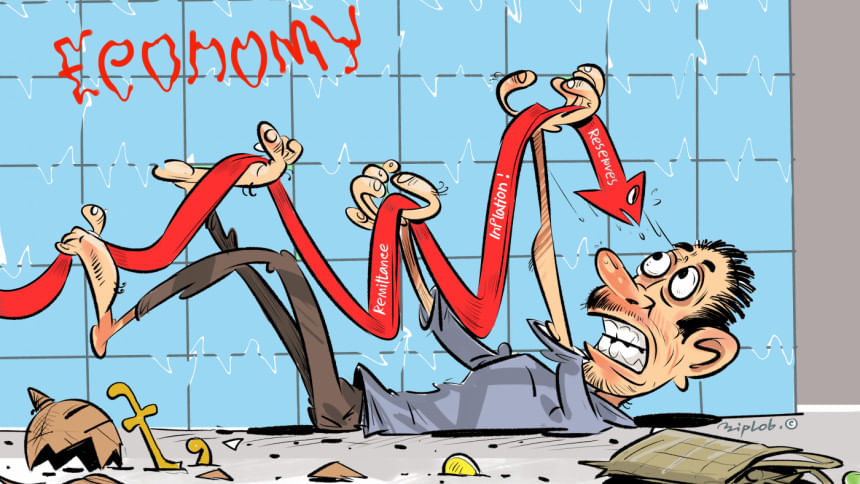Originally posted in The Daily Star on 11 September 2023
 The somewhat comfortable macroeconomic situation that Bangladesh – with high economic growth, low inflation, and good foreign exchange reserves – was experiencing for the last few years has now disappeared. The economic pressure came from high global commodity prices, high imported inflation, and supply chain disruptions. But Bangladesh is not the only country feeling the pressure – every country, rich and poor, has been struggling to recover from the fallout of the pandemic and war in Ukraine.
The somewhat comfortable macroeconomic situation that Bangladesh – with high economic growth, low inflation, and good foreign exchange reserves – was experiencing for the last few years has now disappeared. The economic pressure came from high global commodity prices, high imported inflation, and supply chain disruptions. But Bangladesh is not the only country feeling the pressure – every country, rich and poor, has been struggling to recover from the fallout of the pandemic and war in Ukraine.
However, while countries like Sri Lanka – on the verge of an economic collapse – have begun to turn around, Bangladesh’s economy is still facing difficulties on many accounts. The fiscal year 2022-23 ended with several disquieting factors on the economic front. Most of these problems could not be handled properly due to policy failures.

Notwithstanding marginal fluxes, high inflation has remained a prevailing concern. The Bangladesh Bureau of Statistics (BBS) reported that the monthly average inflation was 9.02 percent as of June 2023, surpassing both the government’s projected rate of 5.6 percent for FY2023 mentioned in the finance minister’s budget speech and the central bank’s projection of 7.5 percent in the Monetary Policy Statement for January to June 2023. To compare, in FY 2022, average inflation was 6.15 percent. Worryingly, latest BBS estimates reveal that average inflation in August 2023 was 9.92 percent while food inflation went as high as 12.54 percent.
Policymakers continue to ascribe the escalation of prices to exogenous factors such as high import prices of essential commodities. However, global prices have been on a downward trend for several months now. Hence, Bangladesh’s inflation cannot be attributed to high import costs anymore. But prices of domestically produced commodities are continuously rising despite ample local production. Market manipulators creating a supply crisis and the inability of policymakers to take any measures against them have left common people undone, since wages have not increased as inflation has.
Most countries, following the Ukraine war, adopted a contractionary monetary policy to control money supply in their respective markets. In contrast, Bangladesh Bank kept interest rates fixed at nine percent for lending and six percent for deposits. High inflation and a low lending rate made money cheaper, encouraging people to borrow. As such, broad money supply (M2) increased to 10.48 percent in FY2023 compared to 9.43 percent in FY2022. BB kept the lending rate low under pressure from the business community. On the other hand, depositors were losing money due to high inflation, which has eroded their purchasing power. Finally in July, Bangladesh Bank adopted a market-based interest rate policy as part of an IMF conditionality for the $4.7 billion loan.
The external sector also has a relation with inflation. Our foreign exchange reserve is increasingly shrinking. With a reserve of $41.8 billion in June 2022, the country was comfortable in terms of spending for its imports and external payments. The gross official forex reserve reached $31.20 billion in June.
But, in July, the central bank started to calculate the forex reserve as per the IMF’s Balance of Payments and International Investment Position Manual (BMP6) method. According to this, our reserve had declined to $23.06 billion by August 30. BB has now excluded the amount disbursed for export development funds, foreign currency loans to local banks, and other funds which are not readily available for use. In the past, the inclusion of these funds made the forex reserve look larger than it actually was.
For the past several years, Bangladesh enjoyed stability in its external sector even during periods of relatively low export performance or sluggish growth in remittance. This provided policymakers with some amount of flexibility and confidence. Regrettably, they failed to make any strategic decisions to address the impacts of the global economic crisis on Bangladesh’s external sector and its macroeconomic situation.
The value of taka was kept artificially high for a long time even though countries such as China, Cambodia, India, and Vietnam had depreciated their respective currencies. A strong currency was helpful for importers, but not desirable to exporters. However, despite the depreciation of taka against the US dollar, export sector performance was not impressive in FY2023. According to data from the Export Promotion Bureau (EPB), export revenue growth was 6.7 percent compared to the government’s target of 11.4 percent. Depressed demand in importing countries has been the main reason behind low export income.
Remittance growth in FY2023 was only 2.7 percent – lower than the rate of migration growth, which was 11.38 percent in the outgoing fiscal year. Serious concerns about the remittance flow have been raised since the increased number of migrant workers departing for foreign labour markets is not reflected in the patterns of remittance flows into the country. It is said that a large volume of remittances come in through hundi. The government’s incentive of two to five percent for remitters is not attractive enough. The cost of sending remittance through formal channels is often higher than the government incentive to do so.
Imports also declined by 15.76 percent in FY2023, which can be attributed to a combination of policy measures and the decline in global commodity prices. The implementation of selective import restrictions, challenges in accessing foreign currency to initiate letters of credit, and the significant depreciation of the taka played crucial roles here. While some degree of import restriction was necessary in view of high commodity prices globally and to control imported inflation, the import of capital machinery and intermediate goods which are crucial for production has been reduced. In view of falling global prices, the import restrictions policy is no longer an effective way to reduce inflation.
The foreign exchange market has also experienced multiple exchange rates, which made it rather chaotic. The central bank’s unified and market-driven exchange rate system allows the exchange rate between the taka and the US dollar (or any other foreign currency) to be determined by the market. BB will no longer provide specific exchange rates for buying or selling foreign currency, thereby promoting market stability. But the outcome of this measure is yet to be observed.
Failure to increase export and remittance earnings has created pressure on Bangladesh’s trade and current account balance. In FY2022, the current account deficit reached negative $18.6 billion for the first time. Trade deficit was also high at negative $33.2 billion. Though the balance of trade and current account balances improved somewhat compared to FY2022, deficits are still high. In FY2023, trade deficit amounted to negative $17.15 billion and current account deficit amounted to negative $3.3 billion.
More worryingly, the financial account deficit recorded in FY2023 was the highest in Bangladesh’s history at negative $2.14 billion. Thus, the overall balance of payments was a negative $8.2 billion in the outgoing fiscal year. Financial account balances encompass foreign direct investment (FDI), remittances, and other investments and are substantial contributors to the forex reserves. The declining reserves result from the deteriorating financial account balances. The strain on reserves has made it extremely difficult to pay for imports and service debt.
High energy prices are another important source of inflation in Bangladesh. The capacity payments made to independent power producers (IPPs), including rental and quick rental power plants, have escalated substantially over the years. Seemingly, the government is trying to earn this amount by hiking energy prices for consumers and producers. The pressure from the IMF to remove subsidies is also forcing the government to raise energy prices at a time when the cost of living is already high. Energy prices have been increased several times since 2021, which contributed to inflationary pressure. There has been a scarcity of natural gas – a primary fuel for power generation – due to the progressive decline in domestic supply. This shortage has been offset by higher imports of liquefied natural gas (LNG) to fulfil unmet demand. There has also been a dearth of public investment in the power and energy sectors even though various geological surveys have indicated the prospect of finding gas in the country.
Government borrowing from the central bank in FY2023 also fuelled inflation by increasing money supply. The inability to generate adequate domestic resources gives little fiscal space for the government to undertake activities such as supporting the poor in times of high inflation. Macroeconomic stability deteriorated further in FY2023 due to higher borrowing from BB, which is equivalent to printing money.
Clearly, the major economic challenges facing Bangladesh are results of inadequate and incorrect policies. Added to this are poor policy implementation, inherent structural weaknesses, lack of good governance, and an absence of reform initiatives. With two months of FY2024 having passed us by, there is still no silver lining in terms of overcoming these challenges. It is also doubtful that any dramatic changes will occur during the rest of FY2024, since all efforts will be devoted to political activities and economic issues may take a backseat.
Dr Fahmida Khatun is the executive director at the Centre for Policy Dialogue and non-resident senior fellow of the Atlantic Council.
Views expressed in this article are the author’s own.

